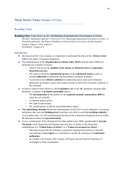Samenvatting
Summary Politics: Africa Week Twelve Reading and Lecture Notes: Dreams of Unity
- Vak
- Politics: Africa
- Instelling
- Universiteit Leiden (UL)
A summary of: - Babatunde Fagbayibo, “From OAU to AU: Rethinking Supranational Governance in Africa”, in Oloruntoba and Falola, The Palgrave Handbook of African Politics, Governance and Development (London: Palgrave, 2018), chapter 47. - Rita Kiki Edozie, “Pan-Africanism is Africa’s Th...
[Meer zien]





